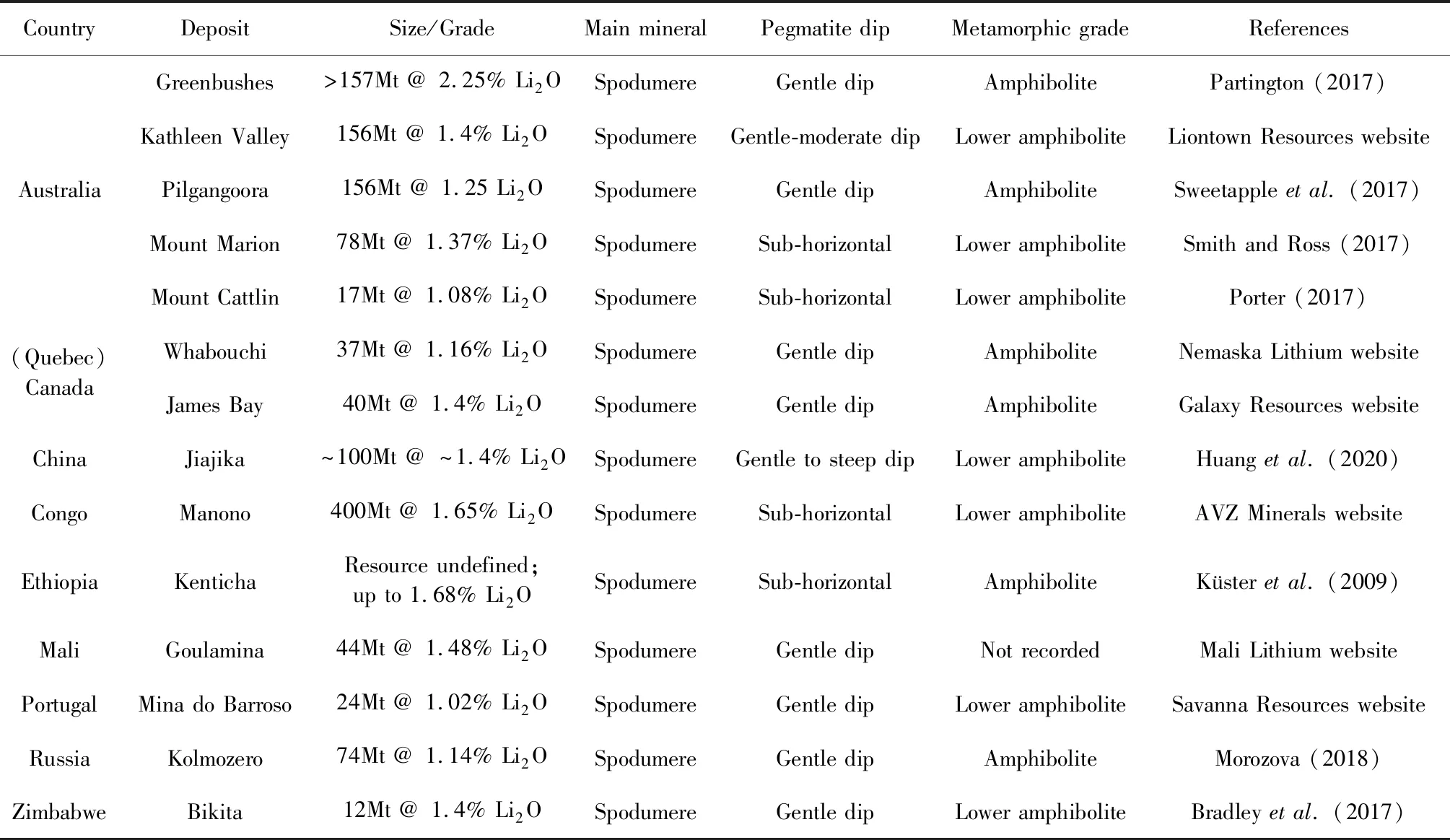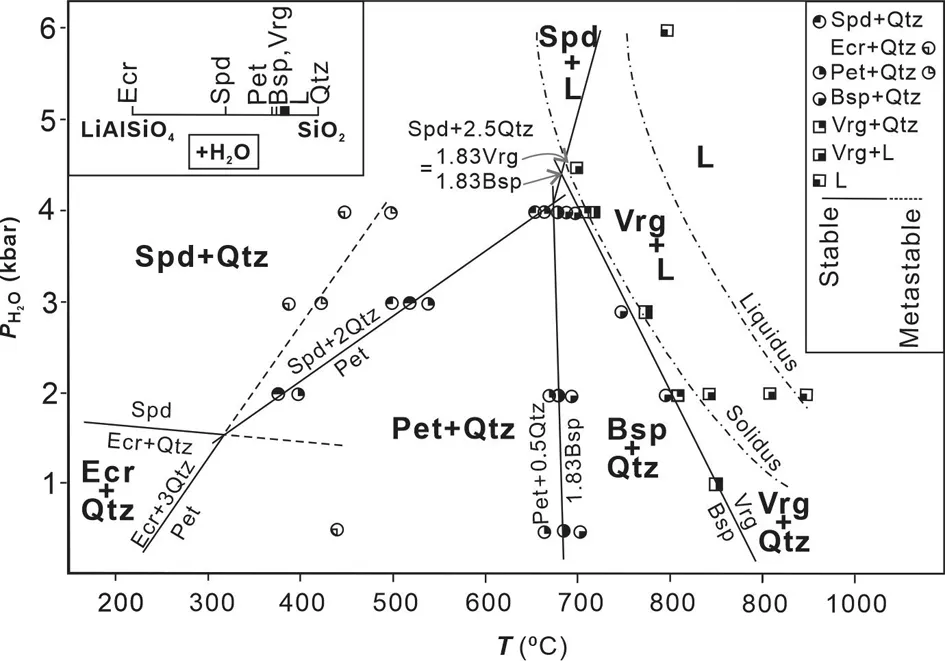Spodumene: The key lithium mineral in giant lithium-cesium-tantalum pegmatites
2022-02-14GROVESDIZHANGLiangGROVESIMandSENERAK
GROVES DI, ZHANG Liang, GROVES IM and SENER AK
1. 中国地质大学(北京),北京 100083 2. 阿斯加德金属有限公司,珀斯 6018 3. 洞见地质有限公司,墨尔本 3178
Abstract As alternate energy sources have become a global issue, the demand for lithium has increased and there has been greater exploration for lithium pegmatite deposits. Although the geology of many of these deposits is poorly documented in the modern literature, it is evident that most major to giant pegmatites have spodumene as the economic lithium mineral rather than other lithium minerals. These largely Archean economic pegmatites throughout the world are normally sub-horizontal to gently dipping, in contrast to many near-vertical pegmatite-swarms, commonly have complex 3D geometries, are strongly mineralogically and geochemically zoned, and are hosted in amphibolite-facies wallrocks. The complex geometries and flat dips are consistent with syn-metamorphic emplacement in dilation zones within a compressional to transpressional regime with a near-vertical minimum principal stress, sigma 3. This would have allowed injection of multiple pulses of lithium-enriched melt and greater time for vertical pegmatite differentiation of volatile-rich pegmatitic melts during prolonged cooling, and importantly, for spodumene to crystallize as the most common medium to high P-T lithium phase in flat-lying lithium-rich zones.
Key words Critical elements; Lithium minerals; Spodumene; Syn-metamorphic pegmatites; Lithium-cesium-tantalum deposits
1 Introduction
As long-lived production of lithium from historic mines and production of other critical elements from Lithium-Cesium-Tantalum (LCT) pegmatites has slowed or ceased, exploration programs have been accelerated to meet increasing demand in this expanding world of technical innovation (Dessemondetal., 2019; Xiongetal., 2020). Many of the world’s largest lithium pegmatite deposits have only been discovered in the past few years and there has been limited published research in scientific journals. Instead, the information is commonly restricted to data on company websites which emphasize exploration success and resource estimates at the expense of geological information on the pegmatites, and particularly on the nature of the host rocks. However, it has become clear that, except in exceptional cases, spodumene (LiAlSi2O6, Fig.1) is the dominant economic lithium mineral, despite the abundance of other lithium minerals (Table 1).
In this short preliminary paper, the reason for the predominance of spodumene in major to giant lithium pegmatites is sought and a robust model developed to explain repetitive critical parameters of the pegmatites and their host environment while realizing that not all critical data are available for the newly discovered deposits and total resources are difficult to assess for historical deposits with significant past production. Many of the references used are quite old because this was when fundamental research on the nature and zoning of the pegmatites was carried out. Apart from the references listed in Table 2, a literature search reveals that most modern references concentrate on specific aspects of lithium pegmatites and do not provide a holistic interpretation. For example, the mineralogy and/or mineral chemistry of associated minerals in spodumene pegmatites are described by Badaninaetal. (2015), Fengetal. (2019), and Maneta and Baker (2019). Knolletal. (2018) and Feietal. (2020) discuss the petrogenesis and geochronology of spodumene pegmatites, and Barros and Menuge (2016) and Liuetal. (2020) discuss the genetic relationships between spodumene pegmatites and adjacent granite intrusions. Wildeetal. (2021) describe a new potentially giant lithium pegmatite province in Mali, and Steiner (2019) reviews the pegmatite literature and sets out pragmatic lithium exploration guides. However, none of these papers with the exception of a description of cristobalite from the Jiajika pegmatite, deal with known giant lithium-cesium-tantalum pegmatites, the subject of this paper.

Table 1 Variety of lithium-bearing minerals commonly found in natural rocks, particularly pegmatites and sediment-hosted deposits

Fig.2 Map of the world showing location of the well-documented major lithium-bearing pegmatites listed in Table 2 (adapted after Bradley et al. 2017)

Table 2 Overview of global major to giant lithium-bearing pegmatites for which there is adequate information on tonnage and grade, and on both pegmatites and host rocks

Fig.3 Geological map and structural model of Greenbushes lithium-bearing pegmatite (adapted after Partington, 2017)(a) map of giant Greenbushes lithium-bearing pegmatite, Western Australia, showing complex shape in amphibolite host rocks; (b) schematic structural model to explain complex zonation of the Greenbushes pegmatite during syn-metamorphic shearing

Fig.4 Simplified geological map of the complex, syn-deformational geometries of the giant Pilgangoora lithium-tin-niobium-tantalum pegmatite swarm (after Sweetapple et al. 2017)Dashed line shows cross section of Fig.5 in this map

Fig.5 Schematic cross section based on diamond drill holes of the Pilgangoora pegmatites showing their gentle dip and consistent lithium grades (adapted after Sweetapple et al., 2017)

Fig.8 Detailed graphic log of intercept at 106~121m in diamond drill hole PLS197M showing remarkable concentrations of Li, Sn, Nb, and Ta over the entire width of the pegmatite (after Sweetapple et al., 2017)

Fig.9 Experimental P-T phase diagram for the bulk system 20 eucryptite 80 quartz (mol/mol) in the system LiAlSiO4-SiO2-H2O, showing stability field of spodumene (adapted after London, 1984: figure 1, with experimental conditions shown)Abbreviations: Bsp-β-spodumene; Ecr-eucryptite; Pet-petalite; Qtz-quartz; Spd-spodumene; Vrg-virgilite
2 Characteristics of large lithium pegmatites with economic ore grades
As noted above, it is not possible to prepare a list of lithium-bearing pegmatite deposits in terms of a consistent set of characteristics for the multitude of global LCT pegmatite deposits compiled by Bradleyetal. (2017). Instead, a more restricted list of many of the largest deposits is provided in Table 2, using the proviso that the deposit is economically significant and has a known resource and, where possible, there is confirmation of the principal lithium phase, and information on the attitude of the pegmatites and nature of the host rocks, particularly their metamorphic grade. To achieve this, mining company websites have been used as a source of information because, as discussed above, many of the newly discovered deposits have no scientific data of research quality. However, as the parameters sought are relatively basic, it is considered that Table 2 is reliable. The global occurrence of these pegmatites is shown in Fig.2. There is some emphasis on Australia because of a 2017 publication that summarizes deposit data.
3 Syn-tectonic and syn-metamorphic timing of emplacement
Several independent lines of evidence suggest that the large to world-class spodumene pegmatites are syn-tectonic and syn-metamorphic bodies. Importantly, they are very rarely planar, more commonly having complex shapes in plan (Fig.3a). They may also have extensive syn-metamorphic metasomatic alteration zones around them (Morgan and London, 1987). In rare cases, a syn-deformational model has been erected to explain both the complex shape and complex zoning of the pegmatites such as the giant Greenbushes pegmatite from the Yilgarn Block of Western Australia (Partington, 1990, 2017; Fig.3b). Another good example of a giant pegmatite with a complex syn-deformational geometry is the Pilgangoora pegmatite from the Pilbara Block of Western Australia (Sweetappleetal., 2017; Fig.4). Most of the economically important lithium pegmatites (Table 2) also have gentle dips or are sub-horizontal, as shown for the Pilgangoora pegmatite (Fig.5) and the giant Kenticha pegmatite of Ethiopia (Küsteretal., 2009; Fig.6). This is entirely consistent with their emplacement in flat-lying dilation zones in a compressional to transpressional stress field in which the minimum principal stress (sigma 3) was subvertical. An analogy can be made to flat-lying extensional or ‘ladder’ veins in late-tectonic orogenic gold deposits (Robert and Paulsen, 2001). The gentle dip of the pegmatites is also critical for most efficient open-cut mining.
4 Significance to formation of world-class high-grade lithium deposits
Pegmatites are typically emplaced at 500~600℃ and may cool rapidly if intruded into cold wall rocks, although Simmons and Webber (2008) demonstrated that the presence of fluxes and volatiles in pegmatite melts may suppress crystallization temperatures as low as 350℃. However, if emplaced broadly syn-tectonically and syn-metamorphically at upper greenschist to amphibolite facies (Table 2), at >500℃, the wall rocks would be at a similar temperature to the pegmatite fluid-rich melt for a significant time. This would slow cooling of even flux- and volatile-rich melts, and thus enhance differentiation and local enrichment of incompatible elements, and promote the formation of giant crystals, although these may also crystallize in post-metamorphic pegmatites (Simmons and Webber, 2008). The sub-horizontal form of the pegmatite bodies would also promote increased efficiency of vertical differentiation of pegmatite melts, with the formation of sub-vertical large to giant crystals (Fig.6c). The inferred sub-horizontal dilation zones into which pegmatite melts were emplaced would also enhance the opportunity for multiple volatile-rich melt influxes with consequent both increase in thickness and critical element enrichment in the resultant pegmatite body (Fig.7). Some authors have inferred such development of multiple melt pulses to explain complexities in pegmatite formation (Nabeleketal., 2010; Andersonetal., 2013). They would also help explain the ubiquitous occurrence of lithium grades of 0.54% to 3.40 % Li2O related to spodumene throughout the entire thickness of some flat-lying pegmatites at Pilgangoora in Western Australia (Sweetappleetal., 2017; Fig.8).
5 Spodumene as the key economic lithium mineral
There are few modern thermodynamic data relating to the stability of lithium silicate minerals. However, based on available experimental data (Stewart, 1978; London, 1984; Chakoumakos and Lumpkin, 1990), the higher pressures of the upper-greenschist to amphibolite facies environments (>2.5kbar) would favor spodumene formation at likely crystallization temperatures of 500℃ to 300℃, thus prolonging crystallization of flux- and volatile-rich melts and favoring the formation of giant crystals (Fig.9). At lower pressures (<2.0kbar) in the greenschist facies, petalite would form at high temperatures, making giant crystals less common. Other lithium silicates form at lower temperatures, explaining their absence in most economic lithium pegmatites.
The anomalous abundance of the economic spodumene-bearing pegmatites in Archean greenstone belts is probably related to a combination of higher heat flow due to mantle plume activity and preservation of environments at the required crustal level due to the long-term stability of Archean cratons with anomalously thick lithosphere (Grovesetal., 2005, and references therein).
6 Conclusions
Largely Archean, economic LCT pegmatites throughout the world are normally sub-horizontal to gently dipping, in contrast to many near-vertical pegmatite-swarms. They were emplaced during regional compression or transpression and regional metamorphism and, as a result, are hosted in amphibolite-facies wallrocks, have complex geometries with flat dips, are strongly mineralogically and geochemically zoned, and have metasomatic reaction zones against their wallrocks. Their flat dips suggest emplacement in dilation zones with minimum principal stress, sigma 3, sub-vertical, which would favor multiple pulses of lithium-rich melt. These syn-metamorphic conditions would have allowed greater time for vertical differentiation of flux- and volatile-rich pegmatitic melts during prolonged cooling, and importantly, expand the opportunity for large crystals of spodumene to crystallize within the criticalP-Twindow of regional metamorphism. These critical parameters can be used to assess the potential of lithium-cesium-tantalum pegmatites to become giant economic deposits through exploration.
AcknowledgementsWe sincerely thank Deng Jun, Yang Liqiang, Wang Qingfei, Zu Bo and Xiong Yiqu for the opportunity to interact with them, and Shen Guanwen, Yu Tianwei, Li Jia and Wang Haoshuai for their help with the first draft of the figures.
